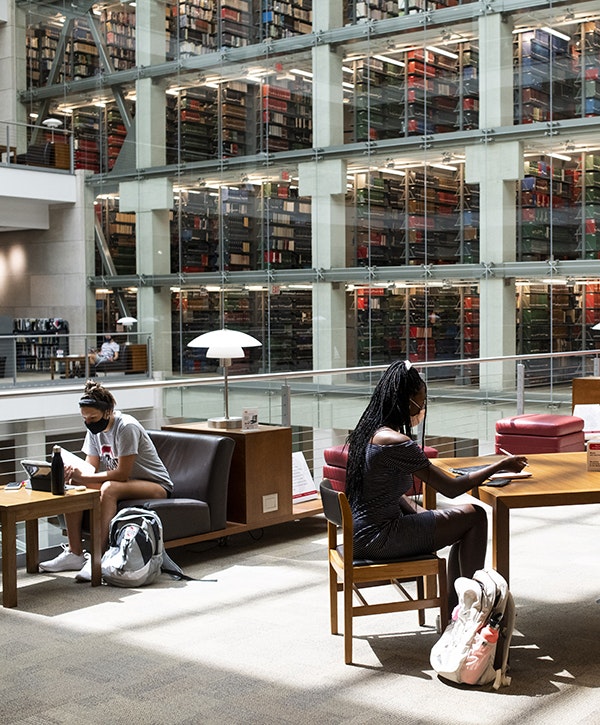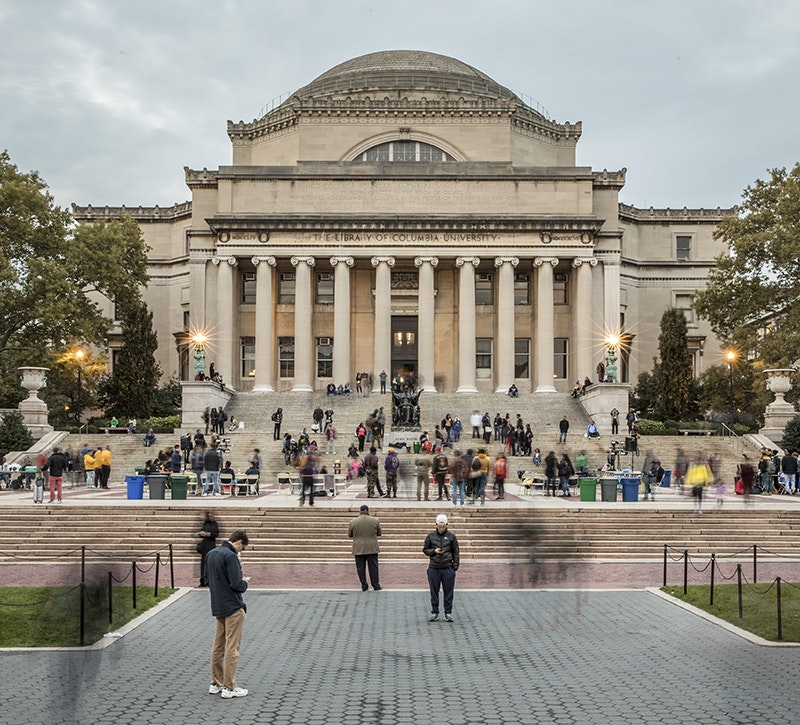The global race for talent is intensifying and the stakes for the United States are high. The U.S. higher education system is a powerful engine of innovation, driving scientific research and development and producing the world’s best educated experts to strengthen our skilled workforce, which in turn benefits communities in every corner of the country. Our ability to attract the world’s most promising talent has long been one of America’s greatest competitive advantages; however, that advantage is imperiled as an outdated immigration system leaves talented international students and graduates without opportunities to stay.
International Students and Graduates in the United States: 5 Things to Know


1,126,690Open Doors Data
foreign-born students were enrolled at U.S. colleges and universities in 2023-2024 school year
1| More than 1 million international students study at colleges and universities across the U.S.
For decades, the United States has been the most popular destination for international students across the globe, even as enrollment rates have fluctuated in recent years.
During the 2023-2024 school year, an estimated 1,126,690 foreign-born students were enrolled at U.S. colleges and universities, representing 5.9% of the total U.S. student population. This includes more than 242,000 international student graduates participating in Optional Practical Training (OPT). Students come to the U.S. from roughly 200 different countries, though more than half are from China and India.
International students are generally admitted on student visas like the F visa (the majority of college, university, high school, and elementary students), and M visa (students attending vocational programs). These are “nonimmigrant” visas, meaning they do not allow a direct path to permanent residency, which creates significant obstacles for international student graduates who wish to stay in the U.S. after they graduate.
International students contributed a combinedNAFSA
$43.8 billion to the economy and supported more than 375,000 jobs
2| International students and graduates grow the economy, create jobs, and benefit U.S.-born students
While living in the United States, international students contribute enormously to their local communities, injecting money into the economy and supporting American jobs. In the 2023-2024 school year, international students contributed a combined $43.8 billion to the economy and supported more than 375,000 jobs across the U.S.
California, New York, Texas, and Massachusetts are home to the largest numbers of international students overall. Those states also boast some of the top receiving schools for international students, along with states like Illinois, Arizona, Indiana, and Michigan.
International students typically pay full tuition rates, providing valuable revenue that subsidizes the cost of attendance for domestic students. A 2015 study found that international students contributed $9 billion to public universities, 28% of their overall total revenue. In turn, these contributions allow schools to increase domestic student enrollment. Universities are also able to support bigger and better graduate programs and research efforts as foreign-born individuals not only enroll in the programs but also serve as faculty and postdoctorate researchers, particularly in science and engineering fields.
And when international graduates stay in the U.S. long-term and work, they create jobs, start new businesses, and raise wages for U.S.-born workers.

3| International students and graduates are critical to the STEM workforce and industries of the future
International students and graduates help America compete on the world stage as well. In order to face growing threats from countries like China, the U.S. must lead in the “industries of the future” like artificial intelligence, 5G, biotechnology, and quantum computing. These are fast-growing fields where demand for knowledgeable workers with specialized science, technology, engineering, and math (STEM) skills continues to grow, fueling concerns about a looming “talent crisis.”
Fortunately, each year, hundreds of thousands of international students pursue advanced STEM degrees at U.S. colleges and universities, providing a valuable pipeline of homegrown, high-skilled talent. Keeping these graduates here is critical to winning the global race for talent.
Nearly 1 million advanced STEM degrees have been earned by international students in the U.S. since 2008, accounting for 45% of all such degrees awarded by U.S. colleges and universities, according to FWD.us analysis of National Center for Education Statistics data. Today, more than half of international students in the U.S. are enrolled in STEM programs, and even though they make up only 5% of the total student population, they continue to earn nearly half of all Master’s and Doctor’s STEM degrees, a total of 103,000 degrees in 2023.
International graduates also fill essential roles in other fields, including healthcare—the majority of international medical graduates, a critical part of the healthcare workforce who make up a quarter of licensed U.S. doctors, are foreign-born, and tend to serve in high-need areas like rural and low-income communities.
The U.S. does not have a post-graduate work visa, and does not offer a specialized pathway to permanent residency for graduates of U.S. schools,
so options to remain and work in the country are limited.
4| Options for international graduates to stay and work in the U.S. are very limited
Despite all this potential, international graduates continue to face significant barriers to contributing their talents here in the U.S. The United States does not have a post-graduate work visa, and does not offer a specialized pathway to permanent residency for graduates of U.S. schools, so options to remain and work in the country are limited. As a result, the majority of international students ultimately leave the U.S. after graduating, and the numbers are increasing.
Optional Practical Training (OPT) is one of the only post-graduation work programs available for international students, allowing graduates to gain hands-on, in-country work experience with U.S. employers in their fields of study. More than 276,000 graduates are enrolled in this valuable program, and it is a major factor drawing international students to choose the U.S. and to remain after graduation.
However, OPT is an imperfect bridge to full employment, as the time limitations and lack of pathway to a permanent status create uncertainty for employers and workers alike. In order to stay in the U.S. after graduating or completing OPT, international graduates have to qualify for an existing immigration pathway (such as family sponsorship or a humanitarian claim), or find an employer who can sponsor them for a visa. Even then, decades-long backlogs make immediate sponsorship for a green card virtually impossible for most, and the annual cap on H-1B visas is well below the amount needed to retain sufficient numbers of international graduates who have already secured job offers.
Countries that the U.S. competes with economically are capitalizing on these difficulties by increasing their recruiting efforts and expanding opportunities for international graduates.
5| The U.S. may be risking its competitive edge as other countries invest heavily in talent attraction and development
More international students are considering leaving the U.S. after graduation and the interest that prospective students have in the U.S. as their higher education destination is dampening, likely resulting from the lack of viable pathways and increased competition from other countries to attract them.
Enrollment rates at U.S. colleges and institutions have fluctuated in recent years. New enrollments began declining under the first Trump administration, in response to restrictions on legal immigration, including travel bans, immigration bans, and policies targeting Chinese students, and then plummeted during the COVID-19 pandemic. Since then, enrollments have recovered, though they have not reached the highs of the mid-2010s, and some experts are warning that 2025 numbers could see a significant decrease again.
Even when students do choose to study in the U.S., it’s becoming increasingly difficult to retain them long-term. A recent FWD.us study that focused specifically on advanced STEM degree programs found that, compared to a couple of years prior, more prospective students were anticipating short-term stays in the U.S. after graduation, three years or fewer. At the same time, participation in temporary programs like OPT and O-1A has increased, illustrating the potential to leverage underutilized avenues for retention.
Countries that the U.S. competes with economically are capitalizing on these difficulties by increasing their recruiting efforts and expanding opportunities for international graduates. Since 2000, the U.S. has lost 20% of its share of the international student market to countries like Canada, the U.K. and Australia. Canada’s international student population reached more than one million in 2023, thanks in part to policies like streamlined pathways to permanent residency that reward in-country education and work experience.
Other countries, like China, are also investing heavily in developing their own talent pipelines with a combination of domestic talent and attracting foreign-born experts, particularly in sectors like AI. For example, DeepSeek AI, a language model launched by a Chinese startup, was developed by experts who were mostly affiliated with Chinese institutions and who had never left China, a shift from the trend of Chinese scientists being educated in the U.S. or elsewhere abroad. Of the researchers who had worked in the U.S., 70% are now based in China, leading analysts to conclude that “the U.S. training pipeline served as a launchpad, not a destination.”
Further limiting options and opportunities for international students—by restricting or eliminating OPT, for example—would only further diminish students’ interest in studying in the U.S. or remaining here after they graduate. It would be an incredible gift to our competitors, sending the world’s best educated and skilled experts away from the U.S. and to their doorsteps. Experts in the global talent space are concerned that early efforts from this administration, including a sweeping effort to force international students out of legal status, will further undermine our global competitiveness.
Solutions to effectively recruit and retain international students and graduates in the United States
The United States has long benefited from being the top destination for international students; unfortunately, our broken and outdated immigration policies, along with fierce competition from other countries, have put our global economic leadership at risk just when the U.S. needs it most.
To address recruiting and retention challenges, Congress must take action, like establishing dedicated green card and post-graduation work programs for international students and graduates. And the administration should abandon arbitrary targeting of international students, protect the vital OPT and STEM OPT programs, and expand access to existing but underutilized avenues like the O-1A visa.
For more information, read our policy recommendations to increase retention of international students and win the global race for talent.
Andrew Moriarty
Immigration Policy Fellow
Tell the world; share this article via...
Read related articles:
Get Involved
We need your help to move America forward. Learn what you can do.





